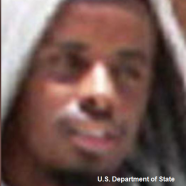Overview
Ahmed Abdi Godane (a.k.a. Mukhtar Abu Zubair) was the leader of Somali terrorist group al-Shabab. While in charge of the group, Godane expanded al-Shabab beyond Somalia and organized several of the group’s major terror attacks, including the 2013 Westgate Mall attack in Kenya.Sudarsan Raghavan, “Al-Shabab leader’s ambitions appear to be as complex as his personality,” Washington Post, September 26, 2013, https://www.washingtonpost.com/world/africa/investigators-search-rubble-of-kenyan-mall-for-bodies-clues-to-bloody-massacre/2013/09/25/b9b383e2-25e5-11e3-b75d-5b7f66349852_story.html?utm_term=.e03d73ef9bff. Godane died in a U.S. airstrike in September 2014.“US confirms al-Shabab leader Ahmed Godane killed,” BBC News, September 5, 2014, http://www.bbc.com/news/world-africa-29086800.
Godane was born on July 10, 1977, in Hargeisa, Somaliland. In the 1990s, he worked with al-Barakaat, a money-transfer company that Somali ex-patriates used to send money to relatives in the country. Al-Barakaat shut down in late 2001 after the U.S. government froze its assets, charging that the company provided funding to Osama bin Laden.Christopher Anzalone, "The Life and Death of Al-Shabab Leader Ahmed Godane," CTC Sentinel, https://www.ctc.usma.edu/v2/wp-content/uploads/2014/09/CTCSentinel-Vol7Iss96.pdf;
Paul Beckett, “Shutdown of Al Barakaat Severs Lifeline for Many Somalia Residents,” Wall Street Journal, December 4, 2001, https://www.wsj.com/articles/SB1007426664516663320. In 1998, Godane traveled to Pakistan to study at a madrassa. From there, he traveled to Afghanistan to fight alongside the Taliban, gaining valuable training and battlefield experience.Nathaniel Horadam, "Profile: Ahmed Abdi Godane (Mukhtar Abu Zubair)," Critical Threats, November 14, 2011, http://www.criticalthreats.org/somalia/al-shabaab-leadership/ahmed-abdi-godane-mukhtar-abu-zubair-november-14-2011.
Godane returned to Somalia in 2001.Christopher Anzalone, "The Life and Death of Al-Shabab Leader Ahmed Godane," CTC Sentinel, https://www.ctc.usma.edu/v2/wp-content/uploads/2014/09/CTCSentinel-Vol7Iss96.pdf. In October 2003, Godane joined al-Ittihad al-Islamiya (AIAI), an al-Qaeda-aligned terrorist organization in Somalia. While a member of the AIAI, Godane was allegedly involved in the murder of several foreign nationals, including Dick and Enid Eyeington, a British couple who had founded a school in the autonomous region of Somaliland.Tristan McConnell, "Who Is Al Shabaab Leader Ahmed Godane?" GlobalPost, October 1, 2013, http://www.globalpost.com/dispatch/news/regions/africa/kenya/131001/who-al-shabaab-leader-ahmed-godane.
In 2006, the Islamic Courts Union (ICU), a predecessor to al-Shabab, appointed Godane as its secretary-general. The ICU took control of Somalia’s capital of Mogadishu in June 2006. That December, Somalia’s transitional government requested an intervention from neighboring countries to quell tension in Mogadishu. Ethiopia, a majority Christian country, invaded Somalia and took Mogadishu with little opposition from the ICU.Jonathan Masters and Mohammed Aly Sergie, “Al-Shabab,” Council on Foreign Relations, last updated March 13, 2015, http://www.cfr.org/somalia/al-shabab/p18650. Following the Ethiopian invasion and the subsequent disintegration of the ICU, Godane was one of the key figures responsible for restructuring al-Shabab.Christopher Anzalone, "The Life and Death of Al-Shabab Leader Ahmed Godane," CTC Sentinel, https://www.ctc.usma.edu/v2/wp-content/uploads/2014/09/CTCSentinel-Vol7Iss96.pdf.
Beginning in 2007, al-Shabab began attracting new recruits and donations. Godane took over the leadership of the group in May 2008 following the death of al-Shabab emir Aden Hashi Ayro in an American airstrike. After Godane’s accession to emir, he released an audio message praising al-Qaeda and pledging allegiance to bin Laden while vowing to carry out attacks on American soil.Frank Chothia, “Ahmed Abdi Godane: Somalia’s killed al-Shabab leader,” BBC News, September 9, 2014, http://www.bbc.com/news/world-africa-29034409.
Godane was responsible for expanding al-Shabab’s terrorist activities beyond Somalia’s border. He organized the July 2010 bombings in Kampala, Uganda, which claimed the lives of 76 people.“In prison with al-Shabab: What drives Somali militants?” BBC News, October 5, 2013, http://www.bbc.com/news/world-africa-24379013. He also orchestrated al-Shabab’s first major violent attack on Kenyan soil, targeting the high-end Westgate shopping mall in Nairobi in a September 2013 attack that killed 67 people.Sudarsan Raghavan, “Al-Shabab leader’s ambitions appear to be as complex as his personality,” Washington Post, September 26, 2013, https://www.washingtonpost.com/world/africa/investigators-search-rubble-of-kenyan-mall-for-bodies-clues-to-bloody-massacre/2013/09/25/b9b383e2-25e5-11e3-b75d-5b7f66349852_story.html?utm_term=.e03d73ef9bff;
Daniel Howden, “Terror in Nairobi: the full story behind al-Shabaab’s mall attack,” Guardian (London), October 4, 2013, https://www.theguardian.com/world/2013/oct/04/westgate-mall-attacks-kenya.
In February 2012, al-Qaeda leader Ayman al-Zawahri formally announced al-Shabab’s alignment with al-Qaeda. Godane had reportedly pursued the alliance for years, but bin Laden opposed the merger. Zawahri, in contrast to his predecessor, moved quickly to grant Godane’s request.Jonathan Masters and Mohammed Aly Sergie, “Al-Shabab,” Council on Foreign Relations, last modified March 13, 2015, http://www.cfr.org/somalia/al-shabab/p18650.
Godane’s leadership of al-Shabab was marked by internal divisions and conflict. Godane was a member of the Isaaq clan, which resides primarily in the northern part of Somalia, while al-Shabab draws its membership primarily from the south. Godane was therefore viewed by some as an outsider and he lacked the clan power base in al-Shabab that is crucial within Somali organizations.Nathaniel Horadam, "Profile: Ahmed Abdi Godane (Mukhtar Abu Zubair)," Critical Threats, November 14, 2011, http://www.criticalthreats.org/somalia/al-shabaab-leadership/ahmed-abdi-godane-mukhtar-abu-zubair-november-14-2011. As al-Shabab losses against forces of the African Union Mission in Somalia (AMISOM) mounted, tensions rose over Godane’s strategy and tactics. The 2010 loss of Mogadishu to AMISOM reportedly humiliated Godane, and many members of al-Shabab rapidly became dissatisfied with Godane’s leadership.Matt Bryden, “The Reinvention of Al-Shabaab: A Strategy of Choice or Necessity,” Center for Strategic & International Studies, February 2014, http://csis.org/files/publication/140221_Bryden_ReinventionOfAlShabaab_Web.pdf;
Jonathan Masters and Mohammed Aly Sergie, “Al-Shabab,” Council on Foreign Relations, last updated March 13, 2015, http://www.cfr.org/somalia/al-shabab/p18650.
Some dissent al-Shabab members took to YouTube and Twitter to air their grievances. Others wrote a letter to al-Qaeda leader Ayman al-Zawahiri to complain that Godane had stacked internal councils with loyalists and fellow clansman while silencing opposition voices. They also lamented Godane’s treatment of foreign fighters and brutality toward fellow Muslims. In March 2012, American al-Shabab member Omar Shafik Hammami posted a YouTube video in which he described leaving the group because of disagreements over sharia (Islamic canonical law) and a fear for his life from Godane.Christopher Anzalone, "The Life and Death of Al-Shabab Leader Ahmed Godane," CTC Sentinel, https://www.ctc.usma.edu/v2/wp-content/uploads/2014/09/CTCSentinel-Vol7Iss96.pdf.
In response, Godane established an internal elite secret police unit called the Amniyat to ensure his control over al-Shabab through a widespread purge of dissidents. Loyal only to Godane, Amniyat spied on rival commanders, carried out assassinations, and was better trained and compensated than other al-Shabab fighters.Jamie Dettmer, "Ahmed Abdi Godane Is Al-Shabab's Osama Bin Laden," Daily Beast, September 5, 2014, http://www.thedailybeast.com/ahmed-abdi-godane-is-al-shababs-osama-bin-laden;
Frank Chothia, “Ahmed Abdi Godane: Somalia’s killed al-Shabab leader,” BBC News, September 9, 2014, http://www.bbc.com/news/world-africa-29034409. Godane ordered his Amniyat to kill a number of his rivals, particularly foreign fighters and even al-Shabab founders. In September 2013, the Amniyat killed Hammami and another foreign fighter, Usama al-Britani.Christopher Anzalone, "The Life and Death of Al-Shabab Leader Ahmed Godane," CTC Sentinel, https://www.ctc.usma.edu/v2/wp-content/uploads/2014/09/CTCSentinel-Vol7Iss96.pdf. The Amniyat reportedly killed more than 200 dissidents.Ken Menkhaus, “Al-Shabab’s Capabilities Post-Westgate,” CTC Sentinel 7, no. 2 (February 2014): 4-9, https://www.ctc.usma.edu/v2/wp-content/uploads/2014/02/CTCSentinel-Vol7Iss2.pdf.
Following the purge, al-Shabab continued to carry out attacks in and around Mogadishu, as well as beyond Somalia’s borders while struggling with its territorial losses to AMISOM. In February 2013, a Puntland military court sentenced Godane in absentia to death for an October 29, 2008, attack in Somaliland’s capital of Hargeisa. Authorities suspected al-Shabab of responsibility the bombing of the U.N. compound and Ethiopian embassy in Hargeisa, which left 28 people dead.Frank Chothia, “Ahmed Abdi Godane: Somalia’s killed al-Shabab leader,” BBC News, September 9, 2014, http://www.bbc.com/news/world-africa-29034409;
Hussein Ali Noor, “Suicide bombers kill at least 28 in Somalia,” Reuters, October 29, 2008, http://www.reuters.com/article/us-somalia-blasts/suicide-bombers-kill-at-least-28-in-somalia-idUSTRE49S2XD20081029;
“Somalia: Puntland President speaks about Al Shabaab leader’s Death,” Garowe Online, September 7, 2014, http://www.garoweonline.com/en/news/puntland/somalia-puntland-president-addresses-al-shabaab-leaders-death.
Godane was killed in a US airstrike in southern Somalia on September 1, 2014, which the U.S. government confirmed four days later.“US confirms al-Shabab leader Ahmed Godane killed,” BBC News, September 5, 2014, http://www.bbc.com/news/world-africa-29086800;
“Statement from Pentagon Press Secretary Rear Admiral John Kirby on Ahmed Godane,” U.S. Department of Defense, September 5, 2014, https://www.defense.gov/News/News-Releases/News-Release-View/Article/605172/.
Associated Groups
- Extremist entity
- Al-Shabab
- Read Threat Report
- Type(s) of Organization:
- Insurgent, non-state actor, religious, terrorist, transnational, violent
- Ideologies and Affiliations:
- Al-Qaeda affiliated group, Islamist, jihadist, Qutbist, Salafist, Sunni, takfiri, Wahhabi
- Position(s):
- Emir (commander) - deceased
Al-Qaeda’s Somali-based branch, al-Shabaab, seeks to establish a fundamentalist Islamic state. The group has carried out a score of violent terror attacks, including the September 2013 Westgate Mall attacks in Nairobi, Kenya.
History
United Nations

The United Nations listed Ahmed Abdi aw-Mohamed pursuant to Paragraph 8 of Resolution 1844 on April 12, 2010.“Security Council Committee on Somalia and Eritrea Issues List of Individuals Identified Pursuant to Paragraph 8 of Resolution 1844 (2008),” U.N. Security Council, April 12, 2010, http://www.un.org/press/en/2010/sc9904.doc.htm.
United States

The U.S. Department of the Treasury designated Ahmed Abdi aw-Mohamed a Specially Designated Global Terrorist on November 20, 2008.“Treasury Targets Somali Terrorists,” U.S. Department of the Treasury, November 20, 2008, https://www.treasury.gov/press-center/press-releases/Pages/hp1283.aspx.
